 Website:
Corin
Website:
Corin
Catalog excerpts
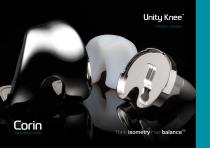
Product overview Think isometry Feel balance™
Open the catalog to page 1
Think isometry Feel balance™ Whilst patients with total hip replacements often categorise their joint as a 'forgotten' hip, even after 40 years of ‘successful’ total knee replacement designs, patient satisfaction remains at 70-80%1,2,3. Various studies and registries have reported some of the biggest causes of total knee revisions to be attributable to instability (15-20%) and pain (20-30%)4,5,6,7. Whilst longevity has been addressed in the majority of total knee designs, today further innovation is needed to improve patient outcomes and quality of life post surgery. Learning from the...
Open the catalog to page 2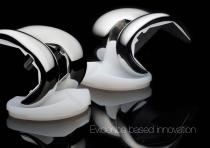
Evidence based innovation
Open the catalog to page 3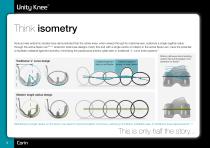
Think isometry Various knee anatomic studies have demonstrated that the native knee, when viewed through its rotational axis, subtends a single sagittal radius through the active flexion arc8,9,10. Anatomic total knee designs mimic this and with a single centre of rotation in the active flexion arc, have the potential to facilitate collateral ligament isometry, minimising the paradoxical anterior glide seen in traditional ‘J’ curve knee systems11. Traditional 'J' curve design Collateral ligament laxity in mid flexion Collateral ligament tension in deep flexion Motion pathways demonstrating...
Open the catalog to page 4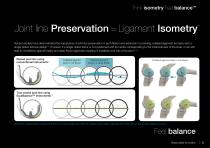
Think isometry Feel balance™ Joint line Preservation = Ligament Isometry Recent studies have demonstrated the importance of joint line preservation in both flexion and extension in providing collateral ligament isometry with a single radius femoral design13. However, if a single radius femur is not positioned with its centre corresponding to the rotational axis of the knee, it can still lead to mid-flexion ligament laxity and deep flexion tightness resulting in instability and loss of function13,14. Raised joint line using conventional instruments Collateral ligament laxity in mid flexion...
Open the catalog to page 5
The challenge Whilst total knee arthroplasty generally demonstrates good implant longevity, the natural joint line orientation is invariably altered during knee surgery due to unequal medial and lateral condylar resection and replacement with equal thickness medial and lateral implant condylar shapes. This may impact patient satisfaction by influencing ligament function15. Traditional instruments rotate around a single central axis which results in elevation of the medial joint line As joint line orientation is not maintained in total knee surgery, most knee arthroplasty instruments today...
Open the catalog to page 6
Think isometry Feel balance™ Balancing the MCL Recent studies have demonstrated the importance of medial collateral ligament stability post TKR15,16. The MCL is an isometric ligament susceptible to changes in strain and therefore function with changes in medial joint line position13,14,15,17. With this in mind, Unity utilises advanced kinematic and design principles with the aim to optimise medial joint stability, providing an optimal synergy between implant and instrument designs. Maintaining the natural joint line with EquiBalance™ instruments True medial joint line using EquiBalance™...
Open the catalog to page 7
A balanced patella Anterior knee pain is a common post-operative complication following total knee replacements, arising from patella imbalance and maltracking post total knee surgery7,19. Recent anatomic studies demonstrate the native patella articulates laterally against the trochlea throughout range of motion20,21,22. The evidence base "The natural patella tracks laterally with its most posterior position being 4.2 ± 1.3mm lateral to the anatomic axis, deviating 1 ±1.3mm medio-laterally from this position through range of motion."20 N M L K J I H G F E "The translation of the sulcus from...
Open the catalog to page 8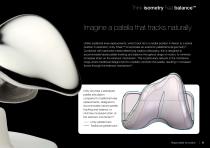
Think isometry Feel balance™ Imagine a patella that tracks naturally Unlike traditional knee replacements, which track from a medial position in flexion to a lateral position in extension, Unity Knee™ incorporates an anatomic patellofemoral geometry23. Combined with optimised medial referencing rotation philosophy, this is designed to accommodate lateral patella tracking and balance throughout range of motion, to minimise increased strain on the extensor mechanism. This is particularly relevant in the mid-flexion range where traditional designs tend to medially constrain the patella,...
Open the catalog to page 9
Balancing the soft tissue envelope The function of the soft tissue envelope goes beyond structural and mechanical support playing an important proprioceptive role in maintaining knee joint stability and minimising sense of pain post knee arthroplasty24. To avoid sensory disturbances that occur due to ligament releases during total knee surgery, the Unity implant design, combined with EquiBalance™ instrumentation, is designed to facilitate ligament balancing and MCL isometry throughout range of motion.
Open the catalog to page 10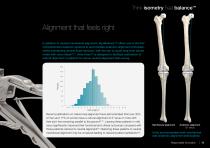
Think isometry Feel balance™ Alignment that feels right In addition to neutral mechanical alignment, EquiBalance™ offers one of the first comprehensive balancer systems to accomodate anatomic alignment principles, whilst maintaining neutral tibial resection, with the aim to avoid long-term issues noted with varus tibiae25,26. Unity Knee™ is designed to facilitate restoration of natural alignment in patients for whom neutral alignment feels wrong. 20.0 17.5 15.0 Recent publications on native knee alignment have demonstrated that over 32% of men and 17% of women have a natural alignment of 3˚...
Open the catalog to page 11
We didn’t just stop there Size-specific tibial profiles Utilising advanced design technologies and anthropometric data analysis, Unity incorporates size specific tibial tray geometries with changing cortical profiles29. This results in an enhanced cortical fit, designed to minimise implant overhang and soft tissue irritation post surgery29,30. Thin anatomic anterior flange Unlike traditional ‘J’ curve designs with a thick anterior flange, Unity incorporates a thin, anatomic anterior flange profile designed to minimise the risk of overstuffing the patellofemoral joint whilst preventing any...
Open the catalog to page 12All Corin catalogs and technical brochures
-
Revival™ 100mm
2 Pages
-
Revival™
2 Pages
-
TriFit TS™
2 Pages
-
Evidence base
8 Pages
-
Dynacup™
6 Pages
-
Dual Mobility™
4 Pages
-
Meije Duo™
4 Pages
-
Linea™
4 Pages
-
Dynacup One-C™
4 Pages
-
MiniHip™ - The evidence base
16 Pages
-
MiniHip™ - product overview
12 Pages
-
Trinity™ - surgical technique
16 Pages
-
Trinity - design rationale
12 Pages
-
clinical excellence
6 Pages
-
Revival™
6 Pages
-
Biomimetic Cementless Technology
12 Pages
-
ECiMa™
12 Pages
-
LARS™
6 Pages
-
Solomax™
4 Pages
-
Zenith™
12 Pages
-
Rotaglide+™
12 Pages
-
MetaFix™
12 Pages
-
TriFit TS™
12 Pages
-
Trinity™ - product overview
12 Pages
-
Optimized Positioning System
12 Pages
-
Uniglide™
28 Pages
-
Unity knee surgical technique
24 Pages
-
TriFit TS surgical technique
12 Pages
-
MiniHip™ - surgical technique
12 Pages
-
OPS™
6 Pages
-
Hip continuum
6 Pages
-
TriFit TS?
12 Pages
-
LARS ACL
12 Pages
-
LARS
8 Pages
-
Solomax
4 Pages
-
Zenith
12 Pages
-
Uniglide
12 Pages
-
Rotaglide+
12 Pages
-
Cormet - product overview
12 Pages
-
MiniHip - design rationale
16 Pages
-
MiniHip - product overview
12 Pages
-
Trinity
12 Pages


















































